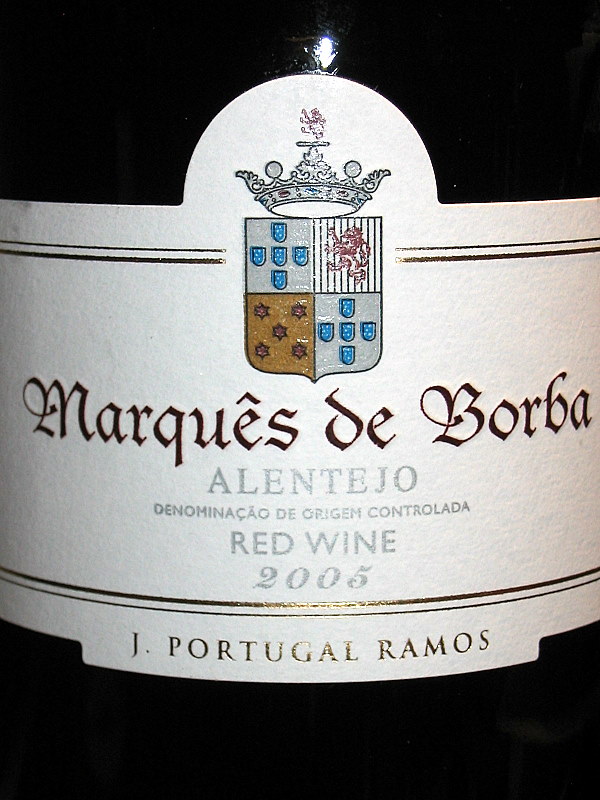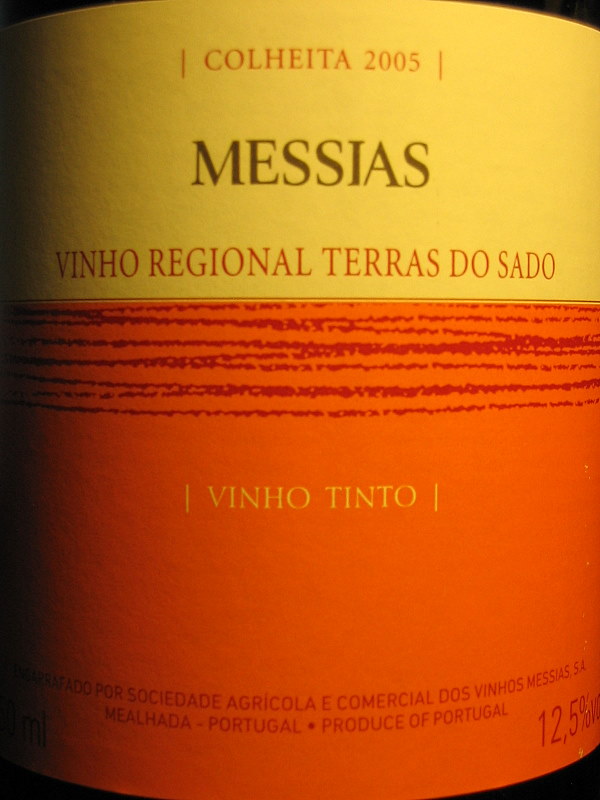This was an exercise in trust for me; I’ve never been a fan of Portuguese table wines, at least nothing other than Vinho Verde, which I like very much. I resolved to take this opportunity to learn a little more about a region I had pretty much written off as producing fruitless bottles of scrape-your-teeth tannic monsters. Many thanks to Catavino‘s Ryan and Gabriella; their Portuguese Table Wine Cheat Sheet was great help to me!
I ended up choosing two wines, both containing the grape Aragones, but each from a different region. Aragones is another name for Tempranillo, star of the Rioja region in Spain. Another Portuguese name for Tempranillo is Tinto Roriz.
Messias Vinho Regional Terras do Sado 2005, $6
Region: Setubal, Portugal
Varietals: 50% Aragones, 50% Castelao Frances
Winery: Caves Messias
Maroon-brick red in color. Pine needles, walnut, black currant/mulberry on the nose. Very menthol at the outset, less once it opens up. Dusty-earthy palate, bit of a sour prune flavor, medium-to-full tannins. Any hint of fruit disappears pretty quickly, leaving a ghost of a cherry pit rolling around in the dust on your tongue. Better with some kalamata olives I had in the fridge. I wouldn’t spend six bucks on this again.
Setubal is a Portuguese region more known for its funny little fortified Muscat wine, named for the region. Messias just started moving into Setubal recently; most of their vineyard land is in Bairrada and Douro. The winery was founded in 1926, and is still family owned. They export about 75% of their wines.
Marques de Borba Alentejo 2005, $12
 Winemaker: João Portugal Ramos
Winemaker: João Portugal Ramos
Region: Alentejo, Portugal
Varietals: Aragones, Trincadeira “and others”
Winery: J. Portugal Ramos
Deep, dark ruby in color. I like this nose better: still dusty, with some heat (this is 14% alcohol) but with some violets, sweet cherry, and rosemary. Wow, though, on the palate this is still a punch in the face — tart cherry, cedar, tar, red currant, and a ninja attack of black tannins. Pleasently long, placid finish; the cherries stick around for the whole show. Interesting – I like this. Also nice with the olives. This wine has a lot of densely packed tastiness for the price. Can’t get enough of that nose!
The Trincadeira should be adding the herbal, floral note to the Marques de Borba, I think. Whatever Ramos did here with the blending, I must say I like it. The Messias should have had its Aragones (Tempranillo) calmed and smoothed by the Castelao Frances, and maybe that why the palate seems so non-existant.
I confess I was expecting a milder, fruitier experience from the Alentejo, but given that it rained so little in 2005, I guess that’s what you get: concentrated, alcoholic wines with more structure than usual. I’m attributing the pruney cast of the Messias to vintage, too.
 J. Portugal Ramos seems to be a bit of a super-star in Alentejo, or even Portugal at large. (And isn’t he a handsome devil?) He’s done lots of consulting in Portugal, and has the largest winery in Alentejo. He takes real care with his winemaking; even the grapes for the Marques de Borba, which is his lowest-priced offering, are hand-picked and destemmed before crush.
J. Portugal Ramos seems to be a bit of a super-star in Alentejo, or even Portugal at large. (And isn’t he a handsome devil?) He’s done lots of consulting in Portugal, and has the largest winery in Alentejo. He takes real care with his winemaking; even the grapes for the Marques de Borba, which is his lowest-priced offering, are hand-picked and destemmed before crush.
There’s a more extensive tasting of J. Portugal Ramos’s wines and a visit to the winery at Wine Anorak. The Wine Cask Blog tasted the Marques de Borba Alentejo 2001, and wrote it up just for you.
Thank you, Wine Blogging Wednesday, for once again pushing me out of my safe little pasture of Wines I Know I’ll Like!

4 replies on “Wine Blogging Wednesday #38: Portuguese Table Wine”
I think we should have a little poll pitting Ramos against Telmo Rodriguez for the title of “most handsome Iberian winemaker”. Want to host that???
[…] Bairrada Vino da Burde: Adega Cooperativa de Cantanhede, Marquis de Marialva Reserva 2001 Wine Scamp: Ramos Pinto, Marques de Borba 2005 […]
Read your report Where can I purchase Marques de Borba (Alentejo) wine in the UK.
Regards
Major Burrows
Major, I see through J. Portugal Ramos’ website that their wines are distributed in the UK by Oakley Wine Agencies in Colchester. Maybe you can give them a call and they can tell you a retail outlet where you can find the Alentejo?
Cheers!